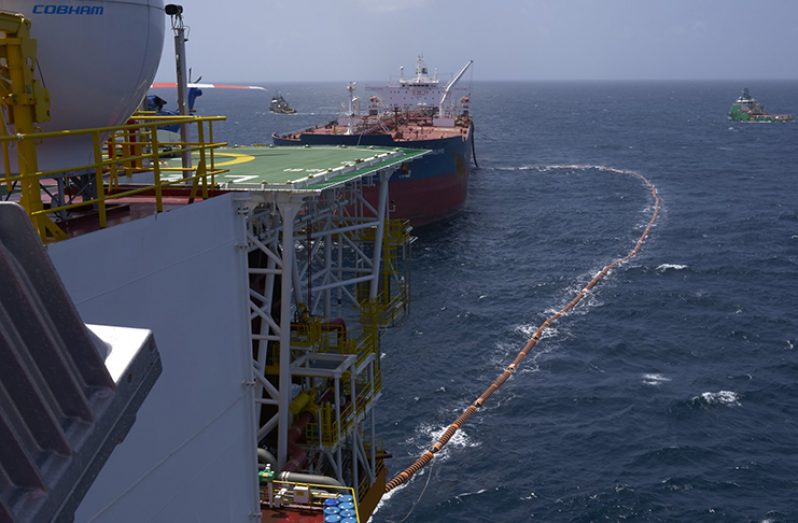By Navendra Seoraj
GUYANA has received US$55 million for its first lift/ the country’s first million barrels of oil, which was sold to Shell Western Supply and Trading Limited, late last month.
The money, as mandated by law, was deposited in the Natural Resources Fund (NRF), which is in the United States of America’s Federal Reserve Bank. This was disclosed by Minister of Finance, Winston Jordan, who was at the time speaking about the possibility of accessing the fund, as a last resort, for Guyana’s response to the Novel Coronavirus (COVID-19) pandemic.
“The fund has US$55 million from the first one million barrels of oil…it will not be available to the government in this period, but it will be available to a successive government,” said Jordan during an interview with the National Communications Network (NCN), on Thursday.
Considering that Guyana is still going through its electoral process and that Parliament has been dissolved, Jordan explained that the fund might be considered a source of funding after the activation of Parliament. He said there is no discretion when it comes to the utilisation of the funds since, according to the NRF Act, there has to be parliamentary approval before the funds can be accessed.

President David Granger had signed into law the Natural Resources Fund Act No. 12 of 2019, which was passed by the National Assembly. The Act provides the legal framework for establishment of the Natural Resources Fund, which will manage the natural resource wealth of Guyana. Guyana’s natural resource wealth had been bolstered by the addition of the oil and gas sector. ExxonMobil’s affiliate, Esso Exploration and Production Guyana Limited, is the operator of the 6.6 million acres Stabroek Block and holds 45 per cent interest in the Block. Hess Guyana Exploration Limited holds 30 per cent interest and CNOOC Petroleum Guyana Limited, a wholly-owned subsidiary of CNOOC Limited, holds 25 per cent interest.
According to a report from Guyana Chronicle, the Liza 1 field, which is in the Stabroek Block, has produced over 2.7 million barrels of oil of which ExxonMobil has had its first two lifts. The Guyana National Bureau of Standards (GNBS) and the Guyana Revenue Authority (GRA) witnessed the first two crude lifting exercises and had reported that “the lifts went very well”.
“These one million barrels is part of our profit oil allocation. It does not include the two per cent royalty, which would be paid on gross productions. So, even though we are having a million barrels lift in this particular instance, we are also receiving two per cent on all oil that is being produced. This gets us away from the perception that all Guyana is getting under the contract is two per cent royalty.
“I am happy to say that Guyana is entitled to approximately five million barrels of oil in 2020 alone, plus the two per cent royalty, plus withholding taxes, plus the direct and indirect benefits through employment creation and other revenue-generated income. So, this is not a contract that we should take lightly, it is not an occasion that we should take lightly,” Director of the Department of Energy, Dr. Mark Bynoe had said.
Shell was nominated as the successful buyer of the government’s first three cargoes, with each cargo being approximately a million barrels of crude. The selection of the successful bidder was based not only on Shell’s global supply and trading capability, but also on a competitive sale with favourable payment terms. The sale of the first three cargoes has been concluded on a Dated Brent price basis, which reflects the tradable, spot market value of crude oil.
Aside from the sale of oil, the oil and gas sector has witnessed Foreign Direct Investment (FDI) in excess of US$500 million; the creation of over 1,700 direct jobs; over 600 service providers and the establishment of over 70 joint ventures, alliances and partnerships which continue to increase.
It has been projected that the oil revenues from this venture alone will realize approximately US$300 million in this first year and more than tripling over the next 5 years.
“This is expected to directly benefit every Guyanese during this Decade of Development through the provision of revenues to develop other important sectors such as agriculture, energy and manufacturing, as well as vastly improved social and educational services, world class infrastructure, increased wages, job opportunities and an overall better quality of life over the long term,” said Dr. Bynoe.
Fuelled by the investments in the new oil and gas sector and the performance of traditional industries, it was reported that the local economy continued to grow and even recorded positive economic growth of 4.7 per cent for 2019, the highest domestic growth since 2014.
While there has been positive growth from 2015, economic growth has been cumulative since 2017, moving from 2.1 per cent in that year to 3.8 per cent in 2018 and to 4.7 per cent last year. The growth recorded last year was more than the projected 4.6 per cent.
New York-based stock market, NASDAQ, had listed Guyana as the fastest growing economy in the world. According to NASDAQ, Guyana’s projected growth rate from 2018-2021 is 16.3 per cent.
The stock market said that with a Gross Domestic Product (GDP) size of $3.63B (2018 Rank: 160), a growth rate of 4.1 per cent in 2018 and 4.6 per cent in 2019, Guyana’s economy is expected to grow by 33.5 per cent and 22.9 per cent in 2020 and 2021 respectively.
Those projections are contained in a report from the International Monetary Fund (IMF), which stated that Guyana’s real Gross Domestic Product (GDP) is expected to grow by approximately 86 per cent in 2020, almost 20 times more than the projected 4.4 per cent growth for this year.
The Economic Commission for Latin America and the Caribbean (ECLAC) has also forecasted a staggeringly-high growth rate for Guyana next year. ECLAC noted that Guyana’s growth rate is pegged at 4.5 per cent for this year, while next year it will be 85.5 per cent.
A report from Bloomberg stated that with such figures, Guyana’s GDP will grow 14 times as fast as China’s next year.
Further projections by the IMF showed that real GDP will grow by 4.8 per cent in 2021, 20.6 per cent in 2022 and 26.2 per cent in 2023. Guyana’s $4B annual GDP is also expected to expand to about $15B by 2024, said the IMF. The financial institution said the commencement of oil production will substantially improve Guyana’s medium and long-term outlook. Guyana is projected to be among the world’s largest per-capita oil producers by 2025.
The oil sector is projected to grow rapidly, accounting for around 40 per cent of GDP by 2024 and supporting additional fiscal spending annually of 6.5 per cent of non-oil GDP on average over the medium term, which will help meet critical social and infrastructure needs.
ECLAC said the Guyana Government will receive approximately 14.5 per cent of all oil revenue in 2020.



.jpg)









